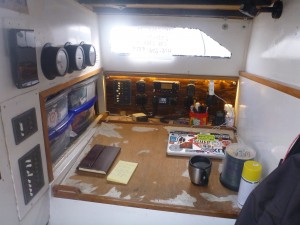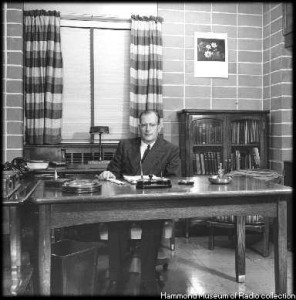“TIE Fighter, TIE Fighter, Estrallita.”
“Estrallita, TIE Fighter, go two-one, over?”
I have to say, one of the things I’ve been enjoying most about La Paz is the active community of sailors monitoring and communicating on their VHF radios. Most of the boats have their radios on listening to channel 22 full time, and there is a popular radio net every morning, giving updates on weather, tides, lost and found, boat arrivals and departures, local news, swaps and trades and more. Seeing how effectively it creates a bond among the sailors in the harbour, I think if I were back in Vancouver I would try to encourage a local False Creek radio net.

The great thing about VHF is that the hardware is cheap and easy to use – the downside is that the functional range of the VHF signal is somewhat low. The signal can go a lot further, from land-based transmitters or larger installations, but for a ship at sea you get about ten kilometres and that’s it.
That’s where higher-power radios come in; on the TIE Fighter I’ve recently (finally!) finished a long, expensive ham radio install. Since then I’ve linked the radio with my laptop, and have been able to use it to send and receive emails from sea and update our current position with the WinLink.org tracking site. Through the emails I’ve also been able to have weather reports and even up-to-the-minute satellite images sent to me, giving us a view of what’s happening over the horizon and letting us know what to expect during those stressful nights at sea when the winds just won’t stop building.
It’s not like data over ham radio is a new concept, though admittedly the number of active hams has been somewhat in decline for the past twenty years and the interest in packet radio doubly so. Ham radio in general has been picking up a little lately, probably in part due to more and more people taking interest in emergency preparedness and doomsday scenarios – nobody really seems to have a land-line telephone anymore, and if there’s a big earthquake or natural disaster of some type, history shows us that the cellphone networks cannot be relied upon. Still, the concept of linking ham radio with the internet has fallen somewhat, due to cheap, fast and ubiquitous internet access. I have not been able as of yet to get a straight TCP/IP connection to the internet over the radio; I’ve only been able to send and receive messages.

For what it’s worth, ham radio is apparently in my blood! Two of my uncles are active hams, and my grandfather on my mother’s side was the Chief Engineer of CBC Radio for many years. “Marconi” Moe Smith was responsible for the design and construction of the huge Radio Canada International 500,000-watt curtain array antenna, broadcasting CBC radio international – to most of the planet – from Sackville, New Brunswick.
It took me thirty years to finally take the plunge and get my ham license, but when I took a certification class with the Bluewater Cruising Association I found myself slapping my forehead in disbelief at the parallels. I have been a certified pocket-protector computer nerd since a very young age, dabbled in homebrew electronics and spent countless hours in front of a bank of analogue synthesizers, all of which contributed to me receiving an honours grade on my ham radio exam.
For the ham radio install, I chose an Icom IC-7000 radio – I considered the Icom IC-706, but I figured if I’m only going to buy the one radio, I should buy one with ample room to grow and features geared towards using the radio specifically for data. In retrospect I’m not sure I gained much going with the newer model, but I’m not dissatisfied with my decision. For a tuner, I was recommended the SGC-230 Smartuner over the matched Icom AT-180, because the SGC-230 can be used with any radio, not just the Icom, and I figured that might come in handy someday if I upgrade (or otherwise destroy) my IC-7000. On other recommendations, I also added a marine voltage booster and a tuner interface device to make the radio and tuner work together even smoother.

For the antenna itself, I had a secondary, non-structural backstay constructed by Ed at Sailing Supply in San Diego. The 3/16″ stainless backstay is somewhat overkill, given that it will never see any serious loads, but at least it’s nice to know that it’s there in case my main backstay ever breaks, and I don’t have to worry about my main backstay losing strength from being cut to add the insulators.
Lastly, I had to add a radio-frequency ground – this is similar to an electrical ground, but for radio-frequency energy. Normally on a sailboat you would connect the RF ground to a series of copper straps that are eventually bound to the huge chunk of metal in the keel, but with TIE Fighter not having a keel I had a bit of a problem on my hands. I would have to add a lot of copper strapping, creating a counterpoise of a few hundred square feet – and with the price of copper currently through the roof, I wasn’t looking forward to dropping hundreds of dollars on copper alone.
I had a recommendation of a new kind of counterpoise, a “KISS-SSB” – apparently a thick rubber hose with over 600 feet of carefully-sized wires inside. It was about a hundred bucks, so I figured I would gamble and give it a shot before forking over for the copper ground. It worked, though I’m not entirely satisfied with the results… I think the real goal of the KISS-SSB is to provide a counterpoise very specific to the small number of frequencies used for Marine-SSB, not the enormous spectrum available to ham radio. I’ve been experiencing a lot of RF feedback in the signal and in the other electronics on the TIE Fighter – everything I read says that this is because my antenna tuner is not properly grounded.
RF grounding for marine radio, as it turns out, is a huge can of worms with many fiercely-defended opinions. I’ve got a few lines out to experts, and I think the next step will be to try replacing the KISS ground with a thick copper wire going to the bolts holding my propellor-shaft strut to the bottom of the boat – it’s one of the very few metal items that make contact with seawater. If the information in this PDF is accurate, I should be able to get away with it – otherwise, I might have to drop the money for copper strapping.

Once all of the parts were installed (including a new VHF radio, a Standard Horizon Matrix AIS+ hurriedly purchased in Sausalito when our previous VHF quietly died the day we were leaving for San Diego) in a newly stained, varnished wood panel, we left offshore for two weeks, giving me a lot of time to spend bent awkwardly over the nav table fiddling with the radio dials. Within a couple of days I had figured out enough to get into Winlink and start sending and receiving emails, which made the trip down feel immensely less isolated. I don’t think I’ve welcomed email from friends and family as much as I did on that trip since my first internet emails almost twenty years ago.
The grand overall cost of the radio equipment and installation was somewhere around $3,000. I was careful to select components that are modular enough that I could migrate the system to another boat or to a land-based station in the future, and I feel like I’ve succeeded in making the setup somewhat “future-proof”. Admittedly I could have spent a third of that on a satellite phone and had $2000 leftover to spend on a data plan, but I don’t feel like a satellite phone would give me the same sense of being a part of a global community as the ham radio has.
Arguably our most important guiding tenet on this boating adventure is to actively strive to be as self-sustained as possible. It would be difficult to call ourselves self-sustained while paying a monthly phone bill to a satellite service! Now that the ham radio is installed, the bills have been paid and the licenses acquired, we’re free to use it for the rest of our lives without any further fees – communicating from virtually anywhere in the world, using power that we generated from the wind and the sun. That’s a good feeling.
Yay for nerdary at sea!
I came here looking for delicious ham, perhaps spiced with rosemary or a lovely honey mustard glaze and all I see is some dirty hippy on a boat with his hot girlfriend with nary a trace of fine pigmeat to been seen.
For shame.
Miss you, btw.
Dude. Mutual. Is there any way we could convince you to come visit?
Whoooo way over my simple head. I have the AT tuner on an Icom 802 with the pactor modem….all plug and play for those of “Electronically Challeged” Great meeting both of you at the shack flor your birthday!! Hope it was a good one.
Yo
Great news on the ham/ssb . Your father cannot figure how you send position reports lol.
Sound like you are having a killer time enjoy as you will remember it for life.
Hey, mux. Great post as always. Glad to hear the travels are going well, and I am anxiously awaiting any bluewater sailing updates!
Your grandfather would be so proud of you!
Talking ground planes in public seafaring places is definitely dangerous stuff.
Here is our install: http://thegiddyupplan.blogspot.com/2011/03/ssb-ground-plane-one-thru-hull-water.html
I just finished enlightening a Garmin for a Puddle Jumper.
The map has stopped updating. Hope you’re well.
Will I ever hear from you again?